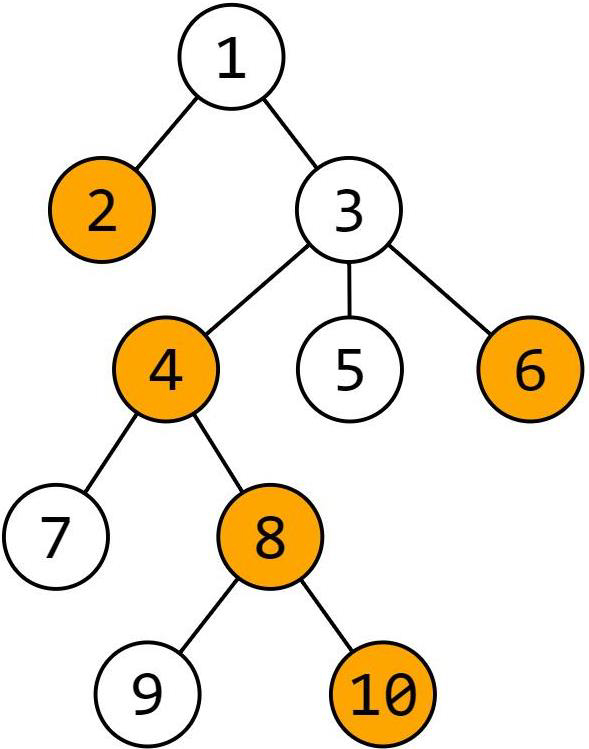Deni is the boss of a company with N workers, numbered from 1 to N. The company structure is strictly hierarchical – every worker (except number 1) has exactly one direct supervisor. So, every worker has 1 or more subordinates (direct and indirect) including himself. For example, worker 1 has exactly N subordinates, including himself. Of course, there isn’t a situation where some subordinate of a worker is his direct supervisor. For some worker x, we will call x a 0-level subordinate. Then, his direct subordinates will be called 1-level subordinates of x. All of their direct subordinates (which are indirect subordinates of x) will be called 2-level subordinates of x and so on.
There is a breaking piece of news that is known by some of the workers. Deni wants to inform all of the company employees. So, multiple times she chooses worker x and number k, and tells the news to all 0-level, 1- level (if they exist), ..., k-level (if they exist) subordinates of x. We will call all these subordinates, k-subordinates of x. The problem with this type of announcement is that most of the time, many chosen subordinates already know the piece of news. That’s why Deni wants a system that can tell her the number of workers among all the k- subordinates of x that have already learned about the news. Write a program that can help her.
Input
From the first line of the standard input read one integer N – the number of workers in Deni’s company. From each of the next N-1 lines read two integers x and y, which show that the worker y is a direct subordinate to the worker x. From the next line read N integers: , where b_i is 1, if the worker i knows the news at the beginning and 0 otherwise. From the next line read one integer Q – the number of queries. From each of the last Q lines, read queries of two types:
- type
1(news announcement query):1 x k– Deni tells the news to all thek-subordinates ofx - type
2(question query):2 x k– Deni asks for the number of the workers that know the news among thek-subordinates ofx
Output
For every query of type 2, on separate lines in the same order as in the input, write one integer – the answer for the corresponding question.
Constraints
0 ≤ k ≤ N
Subtask 1 (0 points)
- The example
Subtask 2 (11 points)
Subtask 3 (15 points)
k = N
Subtask 4 (17 points)
- There are no queries of type
1.
Subtask 5 (26 points)
Subtask 6 (31 points)
- No further constraints.
Example
stdin
10
1 2
1 3
3 4
3 5
3 6
4 7
4 8
8 9
8 10
0 1 0 1 0 1 0 1 0 1
9
2 1 1
2 4 4
2 3 0
1 1 2
2 3 4
1 4 1
2 1 1
2 4 4
2 3 2
stdout
1
3
0
6
3
4
6
Explanation

The above picture shows the hierarchy of the company and the workers that know the news at the beginning are colored in orange.
For the first query 2 4 4:
The 0-level subordinate of worker 4 is 4, the 1-level subordinates of worker 4 are workers 7 and 8, the 2-level subordinates of worker 4 are 9 and 10 and there are no 3-level and 4-level subordinates of worker 4. Workers 4, 8 and 10 know the news, so the answer to this question query is 3.
For query 1 4 1:
The 1-subordinates of worker 4 are workers 4, 7 and 8. Workers 4 and 8 already know the news, so only worker 7 learns the news at this time.
For the second query 2 4 4:
The 4-subordinates of worker 4 are 4, 7, 8, 9 and 10. Workers 4, 7, 8 and 10 know the news, so the answer to the query this time is 4.